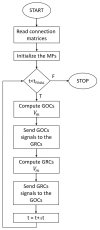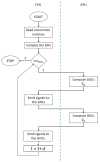Towards the Simulation of a Realistic Large-Scale Spiking Network on a Desktop Multi-GPU System
- PMID: 36290510
- PMCID: PMC9598639
- DOI: 10.3390/bioengineering9100543
Towards the Simulation of a Realistic Large-Scale Spiking Network on a Desktop Multi-GPU System
Abstract
The reproduction of the brain 'sactivity and its functionality is the main goal of modern neuroscience. To this aim, several models have been proposed to describe the activity of single neurons at different levels of detail. Then, single neurons are linked together to build a network, in order to reproduce complex behaviors. In the literature, different network-building rules and models have been described, targeting realistic distributions and connections of the neurons. In particular, the Granular layEr Simulator (GES) performs the granular layer network reconstruction considering biologically realistic rules to connect the neurons. Moreover, it simulates the network considering the Hodgkin-Huxley model. The work proposed in this paper adopts the network reconstruction model of GES and proposes a simulation module based on Leaky Integrate and Fire (LIF) model. This simulator targets the reproduction of the activity of large scale networks, exploiting the GPU technology to reduce the processing times. Experimental results show that a multi-GPU system reduces the simulation of a network with more than 1.8 million neurons from approximately 54 to 13 h.
Keywords: brain modeling; cerebellar network simulation; graphics processing units; high performance computing.
Conflict of interest statement
The authors declare no conflict of interest.
Figures






References
-
- Van Der Vlag M.A., Smaragdos G., Al-Ars Z., Strydis C. Exploring Complex Brain-Simulation Workloads on Multi-GPU Deployments. Front. Comput. Neurosci. 2019;16:1–25. doi: 10.1145/3371235. - DOI
LinkOut - more resources
Full Text Sources

